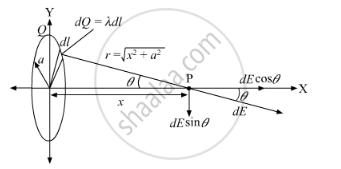Advertisements
Advertisements
प्रश्न
A charge is distributed uniformly over a ring of radius 'a'. Obtain an expression for the electric intensity E at a point on the axis of the ring. Hence, show that for points at large distance from the ring, it behaves like a point charge.
उत्तर
Here, we have a ring of radius a that carries a uniformly distributed positive total charge Q.

We have to calculate the electric field due to a ring at a point P lying a distance x from its centre along the central axis perpendicular to the plane of the ring.
As the charge is distributed uniformly over the ring, the charge density over the ring can be written as follows:
`lambda=Q/(2pia)`
Along the x-axis, the perpendicular components of the electric fields due to charge on the ring cancel each other out.
As there is same charge on both sides of the ring, the magnitude of the electric field at P due to the segment of charge dQ is given by
`dE=k_e (dQ)/r^2`
`E_x= int_"ring"k(dQ)/r^2costheta`
`=int_0^(2pia) k (lambdadl)/r^2 x/r`
`=klambda x/r^3 int_0^(2pia) dl`
`=klambda x/r^3 2pia`
`=kQ/(2pia)x/r^3 2pia`
`=KQx/r^3=KQ x/sqrt((x^2+a^2))^3`
1. At the centre of the ring, the electric field is zero as x = 0.
2. When x >> a , a can be neglected in the denominator compared to x, and the loop looks like a point charge at large distances.
`E=kQ x/sqrt((x^2+a^2)^3)`
`E=kQ/x^2, ("at "x" >> "a)`
संबंधित प्रश्न
What is the amount of work done in moving a point charge Q around a circular arc of radius ‘r’ at the centre of which another point charge ‘q’ is located?
A charged oil drop weighing 1.6 x 10-15 N is found to remain suspended in a uniform electric field of intensity 2 x 103 Nc-1. Find the charge on the drop.
A hemisphere is uniformly charged positively. The electric field at a point on a diameter away from the centre is directed ______.
Electric lines of force about negative point charge are ______
A charge of 4 × 10- 9c is distributed uniformly over the circumference of a conducting ring of radius 0.3 m. Calculate the field intensity at a point on the axis of the ring at 0.4 m from its center and also at the center?
Two equal point charges of the same sign are fixed on the y-axis, on either side of the origin equidistant from it, with the distance between them d. A third charge moves along the x-axis. The distance of the third charge from either of the two fixed charges when force on the third charge is maximum will be ______ cm.
[d = 10 cm]
Consider two identical point charges located at points (0, 0) and (a, 0).
Is there a point on the line joining them at which the electric field is zero?
Consider two identical point charges located at points (0, 0) and (a, 0).
Is there a point on the line joining them at which the electric potential is zero?
